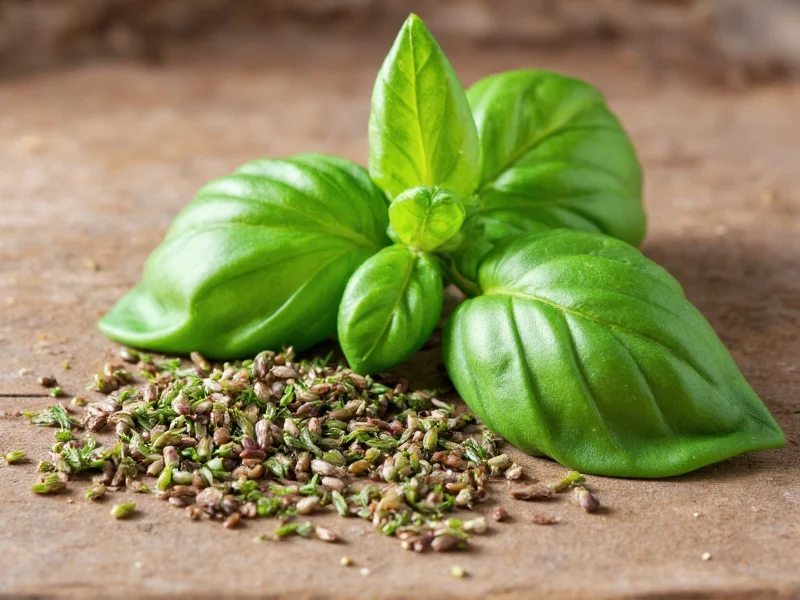Understanding the unique characteristics of basil and oregano transforms your cooking from ordinary to exceptional. These two Mediterranean herbs often appear together in recipes but serve very different culinary purposes. Let's explore their botanical backgrounds, flavor chemistry, and practical applications to help you use them effectively.
Botanical Origins and Varieties
Basil (Ocimum basilicum) belongs to the mint family and originates from tropical regions of Central Africa and Southeast Asia. Popular varieties include sweet basil (most common in Italian cooking), Thai basil (with anise notes), and holy basil (used in Ayurvedic medicine). Oregano (Origanum vulgare) comes from the same family but grows wild across Europe and Mediterranean regions. Greek oregano offers the strongest flavor, while Mexican oregano (a different species) provides citrus notes.
Flavor Chemistry Breakdown
The distinctive tastes stem from different chemical compounds:
| Herb | Primary Compounds | Flavor Profile |
|---|---|---|
| Basil | Linalool, estragole, eugenol | Sweet, slightly peppery, with clove-anise undertones |
| Oregano | Carvacrol, thymol, rosmarinic acid | Earthy, robust, peppery with subtle bitterness |
These chemical differences explain why substituting one for the other without adjustment affects dish outcomes. Carvacrol in oregano creates its characteristic pungency, while basil's linalool provides floral notes that dissipate with heat.
Culinary Applications Compared
Professional chefs treat these herbs differently based on their thermal stability:
- Basil - Add fresh leaves in the last 30 seconds of cooking or as garnish. Heat destroys its delicate volatile oils. Perfect for caprese salads, pesto, and tomato-based pasta sauces.
- Oregano - Benefits from 5-10 minutes of cooking to mellow its sharpness. Essential in pizza sauce, Greek salads, and grilled vegetable marinades. Dried oregano often tastes stronger than fresh due to concentration of oils.
When developing recipes with basil and oregano for Mediterranean dishes, consider regional pairings. Italian cuisine typically uses basil in fresh applications and oregano in cooked tomato sauces. In contrast, Greek cooking features oregano prominently in both fresh and dried forms across meat dishes and dressings.
Substitution Guidelines
Understanding basil versus oregano substitution ratios prevents flavor imbalances:
- For fresh substitutions: Use 1½ parts fresh basil to replace fresh oregano (due to oregano's stronger flavor)
- For dried substitutions: Maintain 1:1 ratio as drying concentrates basil's flavor while slightly mellowing oregano
- When substituting dried for fresh: Remember 1 teaspoon dried = 1 tablespoon fresh for both herbs
Never substitute dried basil for fresh oregano in equal amounts - the flavor intensity differs significantly. For authentic Greek or Italian dishes featuring basil and oregano, maintain traditional proportions to preserve regional authenticity.
Growing and Storage Tips
Home gardeners should know these cultivation differences:
- Basil - Thrives in warm, sunny conditions but hates cold. Pinch flowers to prolong leaf production. Cannot survive frost.
- Oregano - More cold-hardy perennial that spreads aggressively. Tolerates partial shade and poor soil conditions.
Proper storage extends freshness. Keep fresh basil stems in water at room temperature (refrigeration damages leaves). Store oregano in airtight containers in the refrigerator. For long-term preservation, freeze basil in oil cubes while drying works better for oregano due to its hardy nature.
Nutritional Comparison
Both herbs offer health benefits beyond flavor enhancement:
- Basil - Rich in vitamin K (277% DV per 100g), contains antioxidants like orientin and vicenin
- Oregano - Exceptionally high in antioxidants (20x more than blueberries by weight), contains antimicrobial compounds
When incorporating basil and oregano into healthy diets, note that oregano's phenolic compounds remain stable during cooking, while basil's more delicate nutrients benefit from minimal heat exposure.
Common Mistakes to Avoid
Cooks often make these errors with basil versus oregano:
- Adding fresh basil too early in cooking, causing flavor loss
- Using dried oregano in fresh applications like salads
- Substituting equal amounts when switching between fresh and dried forms
- Storing both herbs in the refrigerator (damages basil)
- Using Mexican oregano as direct substitute for Mediterranean oregano
Mastering the proper use of basil and oregano elevates simple dishes through thoughtful herb application. Understanding their unique properties helps create balanced flavors in Italian cooking with basil and oregano, Mediterranean cuisine, and beyond.
Can I substitute oregano for basil in pesto?
While possible, oregano creates a significantly different flavor profile in pesto. For closer results, use half basil and half oregano, plus extra pine nuts to balance oregano's sharpness. Traditional pesto requires basil's sweet notes that oregano cannot replicate.
Which herb works better with tomatoes: basil or oregano?
Both work well but serve different purposes. Basil complements fresh tomatoes in salads and bruschetta with its sweet notes. Oregano enhances cooked tomato dishes like sauces and stews through its earthy flavor that develops with heat. For authentic Italian tomato dishes featuring basil and oregano, use both - basil fresh at the end, oregano during cooking.
Does oregano taste stronger than basil?
Yes, oregano generally has a stronger, more pungent flavor than basil. Fresh oregano is approximately 1.5 times more intense than fresh basil. This difference explains why many Italian recipes with basil and oregano use smaller quantities of oregano compared to basil.
Can I grow basil and oregano together?
Yes, but with considerations. Basil needs more water and warmth while oregano prefers drier conditions. Plant them in separate containers within the same herb garden to accommodate their different moisture needs. Both require full sun but basil cannot tolerate the cooler temperatures that oregano withstands.
Which preserves better: dried basil or dried oregano?
Dried oregano maintains flavor significantly better than dried basil. Oregano's hardy nature allows it to retain 80-90% of its flavor when dried, while basil loses delicate compounds, retaining only 50-60% of fresh flavor. For best results with dried basil and oregano, store both in airtight containers away from light, but use dried basil within 6 months while dried oregano remains potent for 1-2 years.











 浙公网安备
33010002000092号
浙公网安备
33010002000092号 浙B2-20120091-4
浙B2-20120091-4